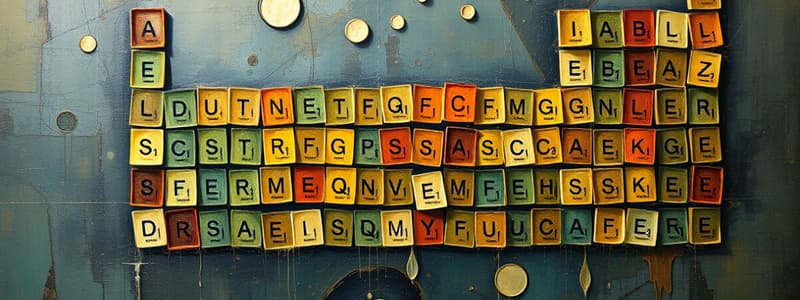Podcast
Questions and Answers
Name the compound: Li2S
Name the compound: Li2S
Lithium Sulfide
Name the compound: CaO
Name the compound: CaO
Calcium Oxide
Name the compound: Mg3N2
Name the compound: Mg3N2
Magnesium Nitride
Write the formula for Zinc Bromide
Write the formula for Zinc Bromide
Write the formula for Magnesium Chlorine
Write the formula for Magnesium Chlorine
Write the formula for Thorium Sulphide
Write the formula for Thorium Sulphide
Name the compounds (use roman numerals): CuBr2
Name the compounds (use roman numerals): CuBr2
Name the compounds (use roman numerals): PbO
Name the compounds (use roman numerals): PbO
Name the compounds (use roman numerals): Hg3P2
Name the compounds (use roman numerals): Hg3P2
Write the formula for Mercury (I) Oxide
Write the formula for Mercury (I) Oxide
Write the formula for Gold (III) Chloride
Write the formula for Gold (III) Chloride
Flashcards are hidden until you start studying
Study Notes
Ionic Compounds Overview
- Ionic compounds are formed by the transfer of electrons between metals and nonmetals, creating charged ions.
- The names and formulas of ionic compounds typically consist of the cation (positive ion) followed by the anion (negative ion).
Common Ionic Compounds and Their Formulas
- Lithium Sulfide: Li2S combines lithium and sulfur.
- Calcium Oxide: CaO consists of calcium and oxygen.
- Magnesium Nitride: Mg3N2 is formed by magnesium and nitrogen.
- Zinc Bromide: Represented as ZnBr2, formed from zinc and bromine.
- Magnesium Chloride: Denoted as MgCl2, consisting of magnesium and chlorine.
- Thorium Sulfide: Written as ThS2, made from thorium and sulfur.
Transition Metal Compounds and Their Nomenclature
- Copper (II) Bromide: Named for Copper with a +2 oxidation state as CuBr2.
- Lead (II) Oxide: Formed of lead with a +2 oxidation state, represented as PbO.
- Mercury (II) Phosphide: Written as Hg3P2 for Mercury in a +2 oxidation state.
Formulas of Specific Ionic Compounds
- Mercury (I) Oxide: The formula is Hg3O, indicating a +1 oxidation state for mercury.
- Gold (III) Chloride: Represented as AuCl3, showing gold in a +3 oxidation state.
Studying That Suits You
Use AI to generate personalized quizzes and flashcards to suit your learning preferences.




